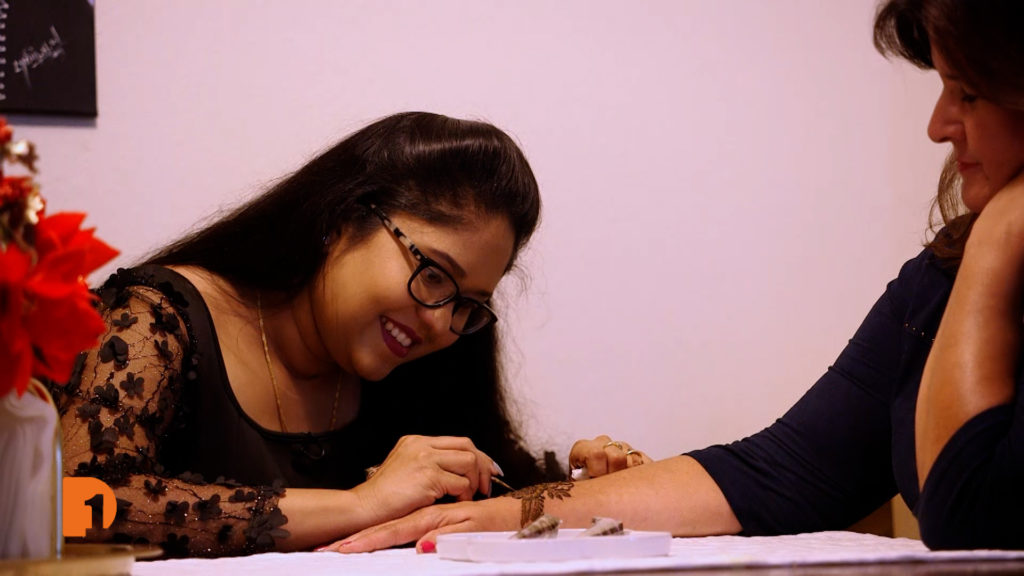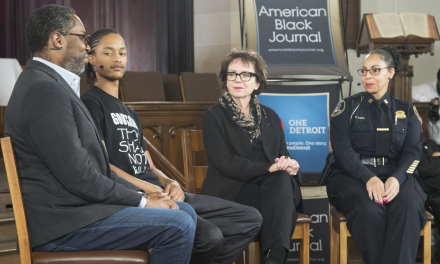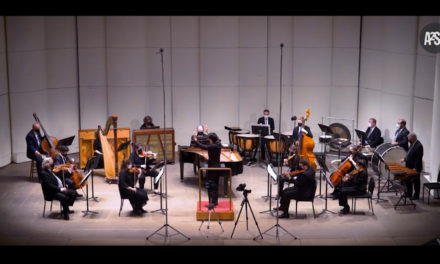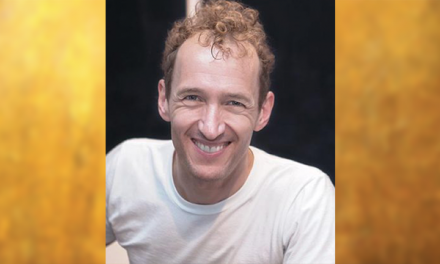Growing up in South India, artist Lydia Hannah Wilson, who found Henna body art at age 10, was always interested in design, though in her culture it was uncommon for young people to study fine arts. As she moved to the United States a few years ago, she brought the cultural traditions of Henna body art to the Detroit community, but what she found in return was a place where she felt free to explore every avenue of her creativity as an artist.
“I think any field, any art, it has to give hope; a sense of living to the person who is seeing it. Not depress them, but encourage them,” Wilson says.

South Indian-born, metro Detroit Henna artist Lydia Hannah Wilson works on a client’s arm. | Photo by One Detroit
The “Detroit Performs: Live From Marygrove” team catches up with Wilson to talk about her start as a henna artist, the different applications of henna art, the cultural history of what henna art represents to Indian culture, and the education of South Indian culture she’s brought to Detroit through her artwork. Plus, Wilson discusses her different art pieces, from freeform paintings to cultural portraits, calligraphy and works reacting to social issues.
Full Transcript:
Lydia Hannah Wilson, Artist: I think any field, any art, it has to give hope, a sense of living to the person who is seeing it. Not depress them, but encourage them. I grew up in a place called Hubli in Karnataka, South India. In India, that’s not really common that people study fine arts. But for me, I always loved design and any empty space, me designing, was my thing. Later it taught me so much more than what textbooks taught me. The way how wind moves; the way how– actually Salma describes nature really well in the Bible, and that really moved me. I mean, if he was able to make songs out of it, why was I not able to do something with paint? That really triggered in my brain.
Henna is an ancient art form. In Indian culture, all the brides apply that like up to here. It’s really crazy, but it takes about 7 to 8 hours just to work on their hands and their feet. The reason why they do it is, they think it enhances the bride. It’s just like an adornment to yourself and it has a lot of health benefits, too. It cools down your body temperature and it’s more like a spa treatment because of the oils and all the beautiful aromas you get in the henna. There is a chemical reaction that happens in the paste. After five, 10 minutes, the stain starts releasing, so it reacts with your skin, which is perfectly normal and organic. It’s nothing to be alarmed of. So the longer I keep the henna paste on my skin, the longer the dye releases.
So I started doing henna when I was 10 years old. My neighbor was a Muslim and it was her wedding, and she got her hands decked up with henna up to here, and that amazed me. And after two days, her stain was still there. And I was like, Oh, this is cool. I mean, it just doesn’t go off, you know, I want to do that, too. There are different applications also, people use a needle-based tube to do henna here; I prefer cone. Cone is nothing but a plastic roll that you roll and then you tape it with a pin. So, the pin gives a proper diameter for the thickness and thinness. I like to work with a fusion of thin and thick lines, so it gives a lot of depth, I feel. There are a few traditional designs for brides especially. They do a lot of portraits in henna, like the bride with a dupatta on her head. The rich heritage and the rich culture, which is in India, many people don’t know in Detroit. So when I do those designs, they’re like, Oh, what is this? What kind of design is this? What kind of an art form is this? So when I explain to them, they’re aware of the culture. They are aware from where it came.
Other forms are like the Arabic forms, more like contemporary forms. When I do brides, I use the embroidery which is on her dress. So, I use those as my inspiration and the love story of the bride. How the bride met the groom? Where did they meet? What is the common thing between them? I sit with them for 8 or 9 hours and they explain to me their entire story. And as they explain their story, I, on the spot, I build a story up in the henna. I think that lightens them and they feel good about it. For me, the time has to stand still when I paint. I want people to see hope when they see my paintings. I’ve recently learned some fluid-based acrylic art, so I wet my entire canvas and I play soft music, this is therapeutic to me. I just put a lot of water on the canvas and just release a little bit of paint and let the paint move in the way it wants to move. That creates its own form, and it’s not bound by any thought or any imagination or something. It just moves freely and I love the freedom of it.
I like painting faces of people just to capture that emotion, just to capture what they feel at that moment. Capturing that story, it’s challenging to me, and I love to take the challenge. There are a lot of news things I’ve seen that really saddens my heart. I was inspired by the persecution that’s happening in China. So that’s like a lady, she is tired, she’s fed up of all the chaos of this world and all of the disappointments and heartaches everywhere. And she’s longing for a place which is serene, which is pure, but she’s not finding it. And she’s just wondering one day, will there be one day? So I like to capture that, “Will there be one day?” on her face.
In India, and not many people know about fonts. So in my fine art college, I came across this beautiful handwriting and it was calligraphy. I thought, I was like, it’s so gorgeous, I would want to learn that. But I never found the supplies to learn how to do calligraphy. When I moved to the U.S., I found the proper techniques of calligraphy and that’s how I learned calligraphy. The thinness and the thickness, it’s more like pen and ink dancing. Calligraphy and handwriting are a ballet for me. It’s just beautiful, the way it curves from perfect sleek lines and then the way it’s elaborated, I just love it. If my paintings are hung anywhere, even in the window or somewhere on the street, if one person is walking by, and if he’s having a hard time in his life, and if my painting could speak life or hope to him, that’s all I need.
Stay Connected:
Subscribe to One Detroit’s YouTube Channel & Don’t miss One Detroit Mondays and Thursdays at 7:30 p.m. on Detroit Public TV, WTVS-Channel 56.
Catch the daily conversations on our website, Facebook, Twitter @DPTVOneDetroit, and Instagram @One.Detroit
View Past Episodes >
Watch One Detroit every Monday and Thursday at 7:30 p.m. ET on Detroit Public TV on Detroit Public TV, WTVS-Channel 56.




